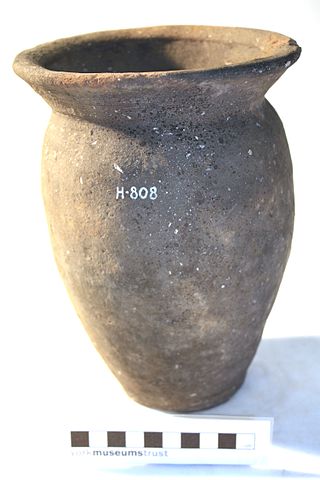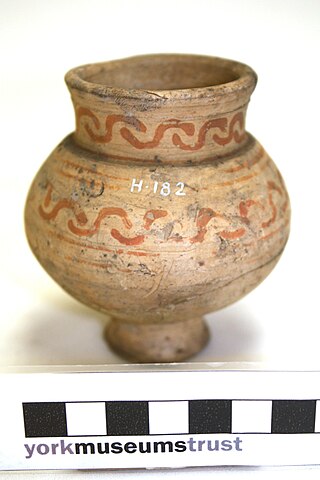
Terra sigillata is a term with at least three distinct meanings: as a description of medieval medicinal earth; in archaeology, as a general term for some of the fine red Ancient Roman pottery with glossy surface slips made in specific areas of the Roman Empire; and more recently, as a description of a contemporary studio pottery technique supposedly inspired by ancient pottery. Usually roughly translated as 'sealed earth', the meaning of 'terra sigillata' is 'clay bearing little images', not 'clay with a sealed (impervious) surface'. The archaeological term is applied, however, to plain-surfaced pots as well as those decorated with figures in relief, because it does not refer to the decoration but to the makers stamp impressed in the bottom of the vessel.

Pottery and ceramics have been produced in the Levant since prehistoric times.

Pottery was produced in enormous quantities in ancient Rome, mostly for utilitarian purposes. It is found all over the former Roman Empire and beyond. Monte Testaccio is a huge waste mound in Rome made almost entirely of broken amphorae used for transporting and storing liquids and other products – in this case probably mostly Spanish olive oil, which was landed nearby, and was the main fuel for lighting, as well as its use in the kitchen and washing in the baths.

Dales ware is a type of pottery produced in the South Yorkshire and Lincolnshire areas of England and widely distributed across northern Britain during the 3rd and 4th centuries AD.

Black-burnished ware is a type of Romano-British ceramic. Burnishing is a pottery treatment in which the surface of the pot is polished, using a hard smooth surface. The classification includes two entirely different pottery types which share many stylistic characteristics. Black burnished ware 1 (BB1), is a black, coarse and gritty fabric. Vessels are hand made. Black burnished ware 2 (BB2) is a finer, grey-coloured, wheel thrown fabric.

Dark faced burnished ware or DFBW is the second oldest form of pottery developed in the western world, the oldest being Dotted wavy line pottery from Africa.

The Younge site is an archeological site located in Goodland Township, Lapeer County, Michigan. It is classified as a prehistoric Late Woodland site and was designated as a Michigan State Historic Site on October 29, 1971. It was added to the National Register of Historic Places on October 29, 1976.
Lohari Ragho is a village and Indus Valley civilization archaeological site, located in Hisar district of the Haryana state in India. It has 3 separate mounds, each 1 to 1.5 km apart within the peripheral suburban zone of Rakhigarhi city cite, where artifacts belonging to Mature Harappan and Sothi-Siswal cultural period have been confirmed based on filed visits. These mounds, unprotected and under risk of encroachment and threat of obliteration, are yet to be excavated, fenced, protected or conserved.

Nene Valley Colour Coated Ware is a type of Romano-British ceramic produced in the lower Nene Valley centred on Durobrivae from the mid-2nd to 4th centuries AD. The closest city is Peterborough, which vies with Northampton, Wisbech and London museums as a main repository and exhibition location of finds, arguably the most impressive of which are at the British Museum. The name of this type of ceramic is often abbreviated to NVCC.

Crambeck Ware is a type of Romano-British ceramic produced in North Yorkshire primarily in the 4th century AD.

Brandsby-type Ware is a type of Medieval ceramic produced in Brandsby, North Yorkshire, England, in the 13th and 14th centuries AD.
The basic chronology of the early town of Manda Island in the Lamu Archipelago of Kenya is divided into 6 different periods, based mostly on the types of imported pottery that has been found in different strata of the excavations. The first period, I, begins in the mid ninth century and is subdivided into four parts, a, b, c, and d, ending in the early eleventh century. Period II has two parts, A and B, though the divide between the two is rather vague and could be entirely arbitrary, and dates from the mid eleventh to the late twelfth for the former, and late twelfth to late thirteenth century for the latter. Period III runs from the late thirteenth century to the fourteenth when Period IV picks up and ends in the early Sixteenth. Period V covers the mid Sixteenth and all of the seventeenth, and the final period covers everything after the Seventeenth century.

Sandy ware, also known as Early Medieval Sandy ware, is a type of pottery found in Great Britain from the sixth through the fourteenth centuries. The pottery fabric is tempered with enough quartz sand mixed in with the clay for it to be visible in the fabric of the pot. Sandy ware was commonly used in Southeast England and the East Midlands.

Cord-marked pottery or Cordmarked pottery is an early form of a simple earthenware pottery. It allowed food to be stored and cooked over fire. Cord-marked pottery varied slightly around the world, depending upon the clay and raw materials that were available. It generally coincided with cultures moving to an agrarian and more settled lifestyle, like that of the Woodland period, as compared to a strictly hunter-gatherer lifestyle.

Surrey whiteware or Surrey white ware, is a type of lead-glazed pottery produced in England from the 13th to the 16th centuries. The white-fired sandy earthenware was produced largely from kilns in Surrey and along the Surrey-Hampshire border. Surrey whitewares were the most commonly used pottery in London during the late medieval period. There are four classes of Surrey whiteware: Kingston-type, Coarse Border ware, Cheam whiteware and Tudor Green ware.

Shelly-sandy ware(SSW) is a type of medieval pottery produced in Great Britain. The pottery fabric is tempered with both sand and shell, most commonly quartz sand and ground-up shell. The fabric is generally dark grey in colour with brown oxidised surfaces. SSW was typically handmade until the potters transitioned to wheel-thrown pottery production. The pottery was manufactured and distributed primarily from 1140—1220 AD in the Greater London area.

Ipswich ware is a type of Anglo-Saxon pottery produced in Britain between the eighth and ninth centuries AD. Manufactured in the Ipswich, Suffolk area, it is considered to be the first wheel-turned and mass-produced pottery in post-Roman Britain. The pottery is a simple, hard grey ware with little or no decoration. Most vessel types include jars, cooking pots and decorated pitchers. Ipswich ware was distributed primarily in eastern Britain, but was also traded in smaller numbers from Kent north to York and west to Oxfordshire.
The Cridling Stubbs hoard is a Romano-British hoard of more than 3,300 coins in a large, ceramic jar.
Hirbemerdon Tepe is an archaeological site in Turkey located in the east of Diyarbakir Province, on the western bank of the Tigris River, 40 kilometers east of Bismil, Turkey. The settlement began in the fourth millennium BCE during the Chalcolithic era, and continued to the time of the Ottoman Empire. The earliest pottery at the site is similar to the chaff-faced ware of Uruk period.















